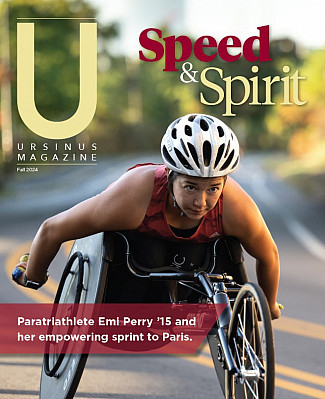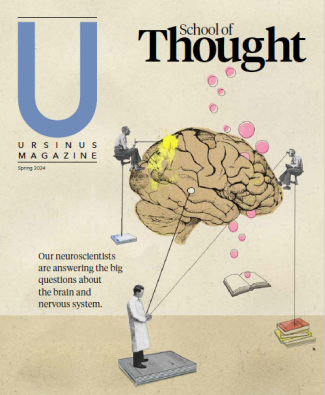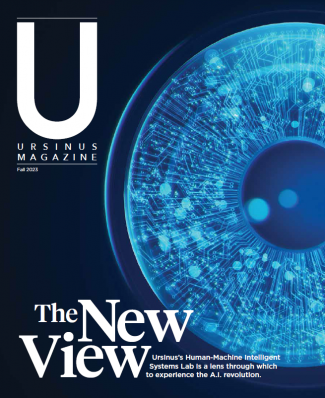Mind-Blowing Pollution
Hiding in plain sight.
Ursinus researchers are wading into local waters to bring microplastic problems to the surface. Read the latest Ursinus Magazine article.
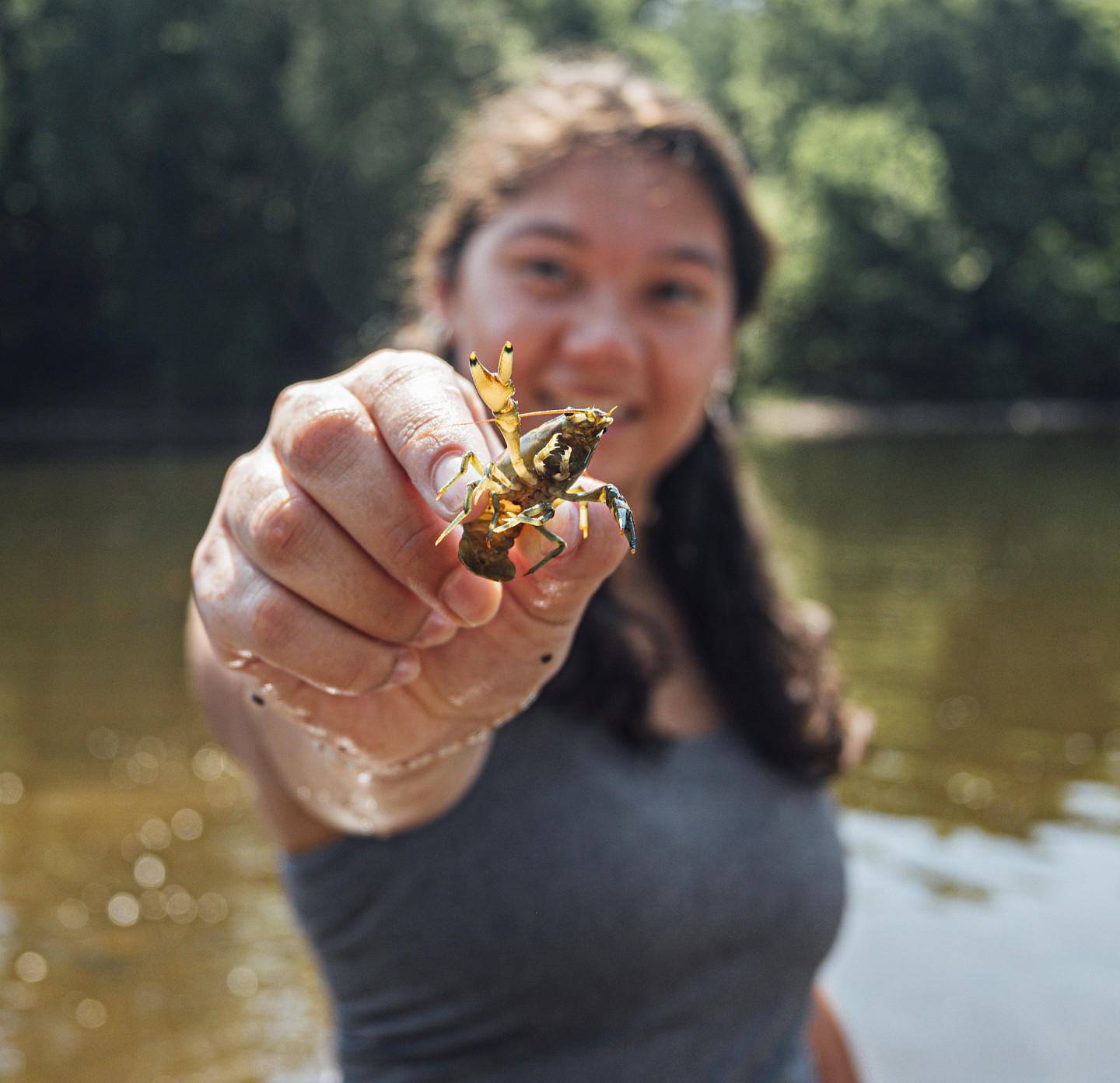
The Perkiomen Creek is just a short walk from the Ursinus campus, its gentle waters a welcome sight on the eastern fringe of an otherwise landlocked community. In the midst of this sizzling summer, it beckoned Assistant Professor of Biology Colleen Bove. Alongside students in her marine biology lab, she pulled on a pair of thigh-high rubber waders and stepped into the creek, where anglers sometimes cast lines for smallmouth bass and catfish. But this wasn’t a fishing expedition—at least not in the traditional sense.
Bove and her students were looking for crayfish and taking water samples as part of ongoing research that seeks to understand the prevalence of microplastic particles in local waterways and their impact on aquatic ecosystems. The project—a collaboration with researchers from Lehigh University, an hour’s drive up the Pennsylvania Turnpike—is focused on both the Perkiomen and the Schuylkill River, into which it empties five miles downstream.
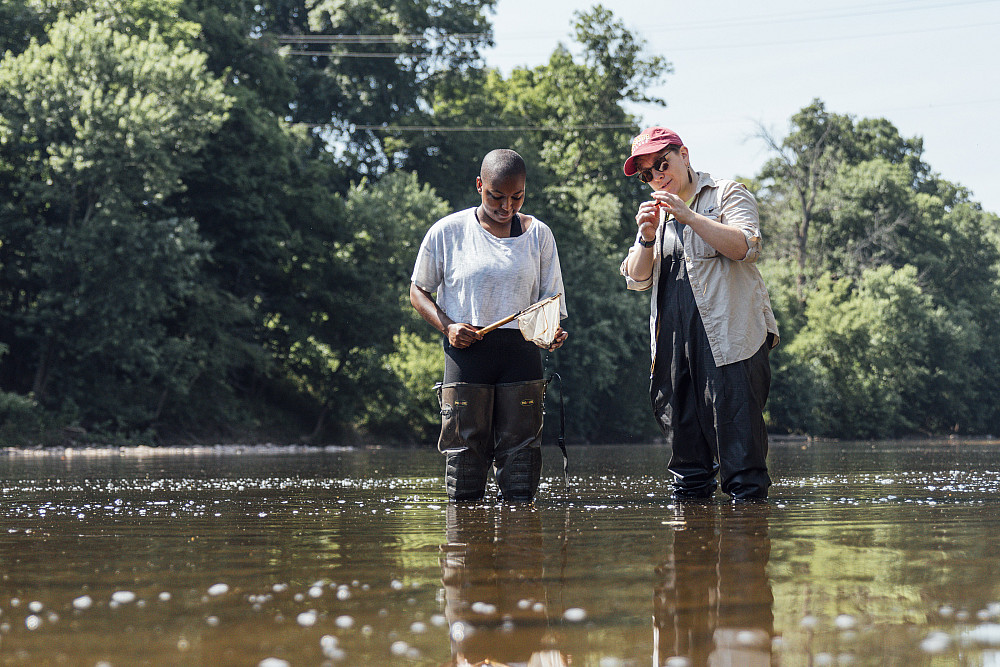
The local waterways may seem clean to the naked eye, but Bove and her students quickly realized there is plastic pollution throughout. Even at the Schuylkill’s headwaters—in theory the most pristine portion of the river—their samples revealed microplastics.
“It’s mind-blowing,” Bove said. “Humans have had such an impact on the planet that areas that are supposed to be relatively untouched and clean are already polluted.”
Every single sample we have pulled so far has microplastics. We don't have any samples that are pristine, which makes sense, but once we actually saw that it was still really shocking.”
Each year we produce nearly 400 million tons of plastic, much of it in the form of single-use materials that won’t biodegrade. But that doesn’t mean they won’t break down. When plastics splinter into smaller pieces in the environment, they leave behind tiny shards that are nearly invisible but nonetheless harmful—to the crayfish in the Perkiomen and everything else they come into contact with. Although their health hazards are still being understood, these microplastics—defined as anything under five millimeters—have been found in human organs, bones, and placenta. A recent study out of the University of New Mexico found that they accounted for 0.5% of the weight in two dozen samples of human brain tissue.
“There’s no running away from them,” said Emily Lybashev ’25, a senior biology major in Bove’s lab on a pre-med track.
While Bove investigates the environmental stress that microplastics place on aquatic ecosystems, her co-principal investigator and counterpart at Lehigh, assistant professor JP Balmonte, is focused on the potential for these materials to serve as a habitat for harmful microbes. Microplastics in our waterways, he said, can serve as “vectors for contaminants” that pose a threat to ecosystem health, offering them a ride downstream or a hospitable environment in which to propagate.
Although the harms of plastic pollution have gained widespread recognition in recent years, the influence of microplastics on our environment and ourselves often goes unnoticed, Balmonte said.
“This is hidden in plain sight to most people,” he said.
With their research, he and Bove are putting the microplastic problem under a microscope to try to change that.

Bove grew up admiring the sea creatures she found along the coast in her native North Carolina and wandering through tidepools in New England, curious to see what she could catch. Steve Irwin’s The Crocodile Hunter documentary series was her favorite TV show. It was “the era of everybody wanting to be a marine biologist,” she said, and she counted herself among them. She found the only school in her home state where she could major in marine biology, UNC-Wilmington, then went to UNC-Chapel Hill for a Ph.D. in ecology.
Before joining Ursinus in August 2023, she had primarily studied corals, including how microplastics and ocean warming and acidification influence the organisms’ gene expression and microbial communities. Her research took her to Florida, Curaçao, Panama, and Belize to collect samples.
“It’s not always as glorious as it sounds,” she admits. “A lot of the time we’re getting destroyed by sand fleas and standing in the sun all day.”
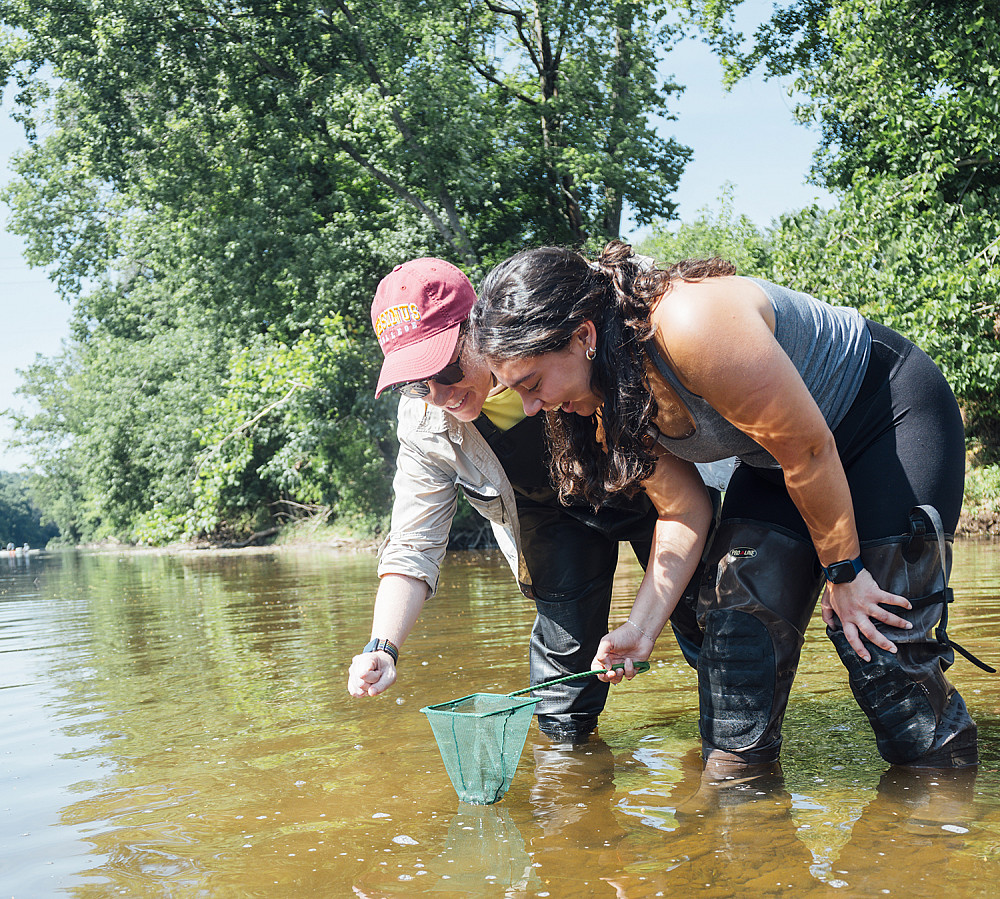
During the pandemic, though, everything paused. She found herself venturing to the shores of the Atlantic near Boston, where she lived at the time, and observing native organisms like marine snails, rather than the coral she’d become familiar with.
“That’s when I realized how important doing more local, accessible research was to me,” she said.
She wanted to be able to teach and research with undergraduates, and that’s how she ended up at Ursinus—and in the middle of the Perkiomen.
Balmonte, meanwhile, started at Lehigh in 2023 and was searching for a project to sink his teeth into. He knew Bove from Chapel Hill, where he earned his Ph.D., and partnered with her to apply for funding from the Pennsylvania Sea Grant, a subsidiary of the National Oceanic and Atmospheric Administration that supports research on the environment and conservation of natural resources. One of the program’s areas of focus is understanding the impact of emerging contaminants, including microplastics, on local waterways.
For the project, which got underway in February and will take two years to complete, Bove and Balmonte have discrete but overlapping interests in understanding the implications of a world filled with microplastics. While she explores their influence on organisms like the crayfish, he is studying them as a habitat for microbial colonization. Their work in the field and in the lab, though, is deeply connected.
Once a week over the summer, Bove, Lybashev, and two other Summer Fellows labmates, Ivy Foster ’25 and Kate Lloyd ’27, went to the Perkiomen to draw samples using a CAMP (Capture Apparatus for Microplastics) that allows them to gauge how contamination changes over time, influenced by shifting temperatures and weather patterns. They brought back crayfish to be studied in the lab, where they’ll be exposed to microplastics to understand how their bodies and behaviors respond.
Lybashev also worked with Balmonte and Lehigh Ph.D. student Alex Korbobo to draw samples from sites along the Schuylkill, all the way from where it begins, in the mountains near Tuscarora, down to South Philadelphia, where it joins the Delaware River before flowing into the Delaware Bay. Among the sites is Upper Schuylkill Valley Park, just west of Ursinus. The spatial sampling will allow the researchers to determine how the microplastic content in the water changes throughout its course; sampling taken across the two-year timeline will allow them to assess shifting patterns. Warmer temperatures, for example, contribute to plastic disintegration and bacteria proliferation, so studying changes by season could offer a window into how microplastics behave in a warmer future.
In the lab at Lehigh, Korbobo taught Lybashev how to chemically process water samples to filter out dirt and organic material, leaving behind only microplastics. Lybashev then used a fluorescent microscope in Bove’s lab to visually count the number of fibers in each sample, and Fourier-transform infrared spectroscopy (FTIR) to identify the chemical components in each sample of microplastics. The work revealed four primary sources of microplastic pollution: tributyl phosphate, a solvent used in inks and adhesives; poly(vinyl formal), used in coating for wires and construction bonding; polyethylene, found in bottles, bags and plastic packaging; and 1,2-polybutadiene, a component of the car tires that wear into the roads along our waterways.
“Every single sample we have pulled so far has microplastics,” Bove said. “We don’t have any samples that are pristine, which makes sense, but once we actually saw that it was still really shocking.”
Even at the Schuylkill’s headwaters, Korbobo saw a speck of pink in a sample that’s yet to be analyzed with FTIR. “It’s been eye-opening,” she said.
As we wait to learn more about microplastics’ effects on human health, their impact on aquatic ecosystems should already be cause for concern, Balmonte said. In water, microplastics attract dense colonies of biofilm that form anoxic patches—areas depleted of dissolved oxygen, which serve as welcoming environments for harmful microbes. In the study, Balmonte is focused on three types, in particular: those that convert mercury into the neurotoxin methyl mercury; those that produce microcystin, a carcinogen; and those that carry antibiotic-resistant genes.
“For the public community and the local community, I think it’s very important that people know what’s going on in their local waterways,” Balmonte said, “even if they can’t see it.”
At both Ursinus and Lehigh, the researchers will continue sampling the Perkiomen and the Schuylkill over the next two years as they work to develop a deeper understanding of the scale of the microplastic problem. In time, Korbobo will compile all the information they gather into an open-source database that can inform future research and offer community members and policymakers a window into the state of the local waterways.
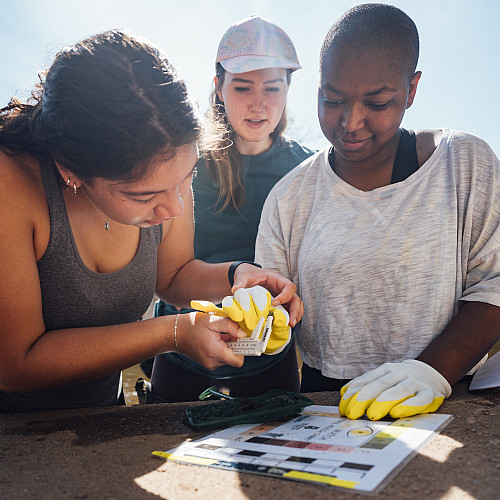
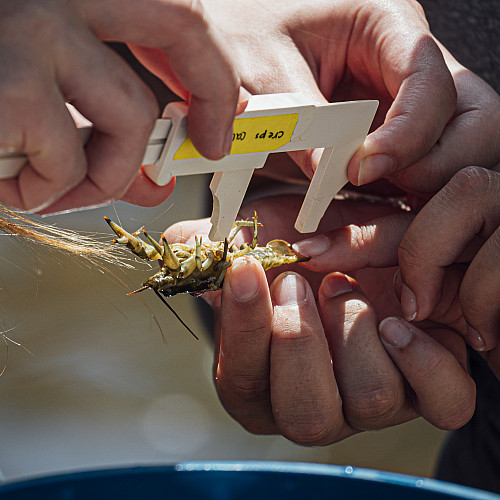
The researchers are also planning citizen science days, where they can teach community members about microplastics and water sampling protocols so they can contribute their own findings. The grant funds collaboration with the Da Vinci Science Center and the Master Watershed Steward Program that will support that effort.
In the midst of a global plastics crisis, the research will shed light for the first time on some of the local implications of all that pollution.
“This is an emerging contaminant we don’t know a lot about,” Korbobo said of microplastics. “It’s important to see how the influx of this pollutant is actually happening in different areas of the watershed to hopefully influence lawmakers that single-use plastics are not things we should be using in the future.”
It’s too early for Bove and Balmonte to report any findings from their work, but they believe it will help demonstrate the prevalence and potential harm of microplastic pollution in the region’s aquatic ecosystems.
“Even if you can’t see them,” Bove said, “it doesn’t mean they’re not impacting you.”
Bove said she was given a great deal of freedom as an undergraduate, becoming one of those rare students to publish her research. At Ursinus, she wants to give the same opportunity to her students to explore their own curiosity. This fall, her lab is set to expand from three members to eight, bringing in more students like Lybashev and Lloyd, an environment and sustainability major who came to Ursinus hoping to conduct research in the field. She got her chance this summer and learned that the local waterways are “so much more delicate” than she had imagined, she said.
“I grew up in rural Pennsylvania, so we used the creeks as swimming holes, but you don’t really get the full impact of what humans are doing to the animals in there,” she said.
For Lybashev, her time in the field and in the lab thus far has been “transformative,” solidifying her desire to study human health and to continue research in medical school, she said. While there’s still plenty of work to be done on the project led by Bove and Balmonte, she’s already learned an important lesson about the pollution in local waters and how it’s changing their health.
“Now,” she said, “whenever I go to a lake, I’m not swimming.”

